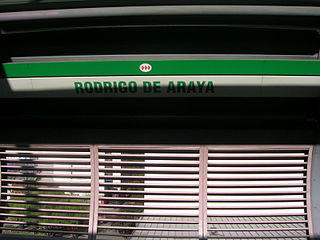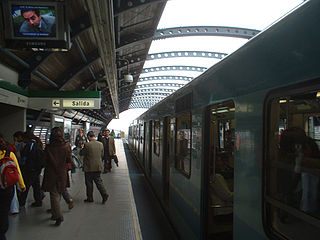
The Paris Métro, operated by the Régie autonome des transports parisiens (RATP), is a rapid transit system in the Paris metropolitan area, France. A symbol of the city, it is known for its density within the capital's territorial limits, uniform architecture and unique entrances influenced by Art Nouveau. The system is 226.9 kilometres (141.0 mi) long, mostly underground. It has 308 stations of which 64 have transfers between lines. There are 16 lines, numbered 1 to 14, with two lines, 3bis and 7bis, named because they started out as branches of Line 3 and Line 7, respectively. Line 1, Line 4 and Line 14 are automated. Lines are identified on maps by number and colour, with the direction of travel indicated by the terminus.

Bastille is a station on Line 1, Line 5 and Line 8 of the Paris Métro. Located under the Place de la Bastille and near the former location of the Bastille, it is situated on the border of the 4th, 11th and 12th arrondissement.

La Motte-Picquet–Grenelle is a station of the Paris Métro, at the interconnection of line 6, line 8, and line 10 in the 15th arrondissement. The station combines underground and elevated platforms. It is a major métro interchange on the Rive Gauche, the biggest west of Montparnasse.

The Santiago Metro is a rapid transit system serving the city of Santiago, the capital of Chile. It currently consists of seven lines, 143 stations, and 149 kilometres (92.6 mi) of revenue route. The system is managed by the state-owned Metro S.A. and is the first and only rapid transit system in the country.

The Rio de Janeiro Metro, commonly referred to as just the Metrô is a rapid transit network that serves the city of Rio de Janeiro, Brazil. The Metrô was inaugurated on 5 March 1979, and consisted of five stations operating on a single line. The system currently covers a total of 58 kilometres (36 mi), serving 41 stations, divided into three lines: Line 1 ; Line 2, which together travel over a shared stretch of line that covers 10 stations of an approximate distance of 5 kilometres (3.1 mi); and Line 4. Metrô Rio has the second highest passenger volume of the metro systems in Brazil, after the São Paulo Metro.

Platform screen doors (PSDs), also known as platform edge doors (PEDs), are used at some train, rapid transit and people mover stations to separate the platform from train tracks, as well as on some bus rapid transit, tram and light rail systems. Primarily used for passenger safety, they are a relatively new addition to many metro systems around the world, some having been retrofitted to established systems. They are widely used in newer Asian and European metro systems, and Latin American bus rapid transit systems.

Line 6 is one of the sixteen lines of the Paris Métro rapid transit system. Following a semi-circular route around the southern half of the city above boulevards formed by the former wall of the 'Fermiers généraux' built between 1784 and 1791, it runs between Charles de Gaulle – Étoile in the west and Nation in the east.

Del Amo station is an elevated light rail station on the A Line of the Los Angeles Metro Rail system. The station is located between Compton Creek and Santa Fe Avenue, and elevated over the intersection of Del Amo Boulevard, after which the station is named, in the Los Angeles County community of Rancho Dominguez and near the city of Carson.

Macul is a metro station on the Line 4 of the Santiago Metro, in Santiago, Chile. The station occupies the central viaduct of three adjacent overpasses. The other elevated bridges carry three one-way lanes each of Vespucio Sur. It is located on the site of a former roundabout, where Américo Vespucio Avenue, La Florida Avenue, Macul Avenue and Departamental Avenue used meet. The latter ones currently pass under the aforementioned viaducts, as does a canal called Zanjón de la Aguada. The station was opened on 2 March 2006 as part of the connection between Grecia and Vicente Valdés.

Ñuble is a transfer station between the Line 5 and Line 6 of the Santiago Metro. The station has street-level platforms with an underground ticket hall, which is accessed from the south sidewalk of the underpass under the station, which carries Carlos Dittborn Avenue. That street originates half-block west of the station as the continuation of Ñuble Street, which gives its name to the station. The Line 5 station was opened on 5 April 1997 as part of the inaugural section of the line, from Baquedano to Bellavista de La Florida. The Line 6 station was opened on 2 November 2017 as part of the inaugural section of the line, between Cerrillos and Los Leones.

Rodrigo de Araya is an elevated metro station on the Line 5 of the Santiago Metro, in Santiago, Chile. The station consists of an elliptical cylindrical structure enclosing the side platforms and tracks. Staircases jut out from the tubular structure and lead to the concourse level, which is located below the viaduct deck. The station was opened on 5 April 1997 as part of the inaugural section of the line, from Baquedano to Bellavista de La Florida.

Carlos Valdovinos is an elevated metro station on the Line 5 of the Santiago Metro, in Santiago, Chile. Platforms were lengthened in 2012 to accommodate seven-car trains. The station was opened on 5 April 1997 as part of the inaugural section of the line, from Baquedano to Bellavista de La Florida.

Camino Agrícola is an elevated metro station on the Line 5 of the Santiago Metro, in Santiago, Chile. It is similar in design as the adjacent stations. The station was opened on 5 April 1997 as part of the inaugural section of the line, from Baquedano to Bellavista de La Florida.

San Joaquín is an elevated metro station on the Line 5 of the Santiago Metro, in Santiago, Chile. It is located close to the San Joaquín Campus of the Pontifical Catholic University of Chile. The station was opened on 5 April 1997 as part of the inaugural section of the line, from Baquedano to Bellavista de La Florida.

Pedrero is an elevated metro station on the Line 5 of the Santiago Metro, in Santiago, Chile. It is located close to the Estadio Monumental David Arellano. The station was opened on 5 April 1997 as part of the inaugural section of the line, from Baquedano to Bellavista de La Florida.

Plaza de Maipú is an underground metro station on Line 5 of the Santiago Metro, in Santiago, Chile. The station is located under the Plaza de Armas of Maipú. It was formerly the deepest station in the Santiago Metro system at 28 metres (92 ft) deep. However, this has since been surpassed by the Line 3 platforms at Puente Cal y Canto station. The station was opened on 3 February 2011 as the southwestern terminus of the extension of the line from Pudahuel to Plaza de Maipú.

Santiago Metro Line 5 is one of the seven lines that currently make up the Santiago Metro network in Santiago, Chile. It has 30 stations and 29.7 km (18.5 mi) of track. The line intersects with Line 1 at Baquedano station and San Pablo station, with Line 2 at Santa Ana station, with the Line 3 at both Plaza de Armas station and Irarrázaval station, with Line 4 at Vicente Valdés station, and with line 6 at Ñuble station. It will also intersect and the future Line 7 at Baquedano station. Its distinctive colour on the network line map is green.

Príncipe Pío is a multimodal train station in Madrid, Spain that services Madrid Metro's Line 6, Line 10, and Ramal; Cercanías Madrid's commuter rail lines C-1, C-7, and C-10; and city buses and intercity and long-distance coaches. It is located next to the River Manzanares between the San Vicente roundabout and the streets of Cuesta de San Vicente, Paseo de la Florida, and Paseo del Rey in the district of Moncloa-Aravaca. It is one of the busiest stations in the Madrid Metro and Cercanías systems.

Las Parcelas is a metro station on the Line 5 of the Santiago Metro, in Santiago, Chile. The station was opened on 3 February 2011 as part of the extension of the line from Pudahuel to Plaza de Maipú. It is one of the three stations built on a viaduct on the expansion.

Zapotitlán metro station is a station of the Mexico City Metro in the town of Santiago Zapotitlán and in the colonia (neighborhood) of Conchita Zapotitlán, in Tláhuac, Mexico City. It is an elevated station with two side platforms, served by Line 12, between Nopalera and Tlaltenco metro stations. The station's pictogram features the glyph of Santiago Zapotitlán, which shows a toothed sapote tree with three branches. The station was opened on 30 October 2012, on the first day of service between Tláhuac and Mixcoac metro stations.






















